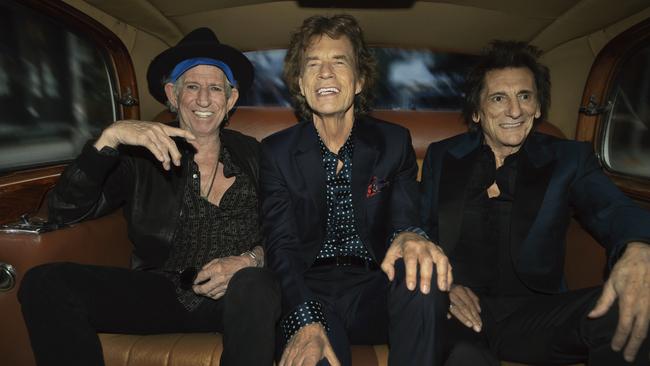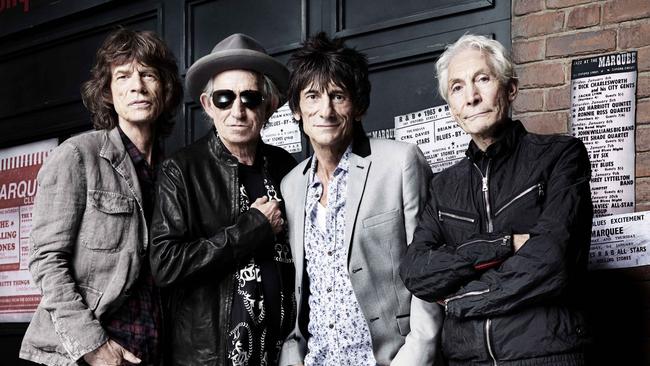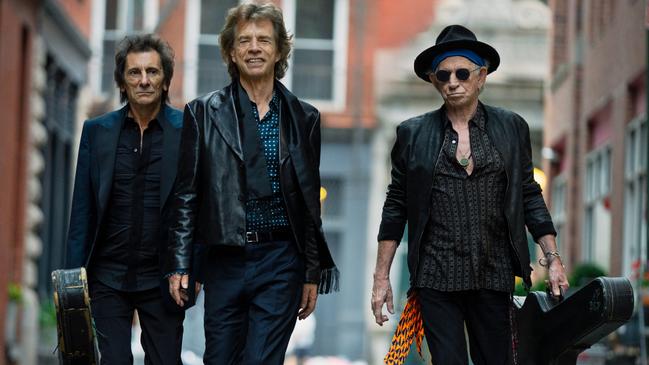Hackney Diamonds and the Rolling Stones’ long, strange trip as rock ‘n’ roll survivors
A look back at the formative British band’s chequered 61-year history, and the release of its first new music in 18 years — a surprising and compelling set of songs titled Hackney Diamonds.

The question was formed in the liquid mercury fashion of one of the master guitarist’s best riffs, before shapeshifting into a profound statement that reached for the stars.
“What’s it like to live in a world where the Stones were always there?” asked Keith Richards. “For you, there’s always been the sun and the moon and the Rolling Stones.”
For a young writer on assignment for Rolling Stone magazine in 1994, Richards’s offhand quip made for a tasty quote in yet another feature article about one of the defining musical groups of the past century.
But what the revered guitarist and songwriter captured in that remarkable couplet was a deep, chiming tone that continues to echo today, as the band issues its 24th album, titled Hackney Diamonds.
As its first collection of new material since 2005, the release is another surprising achievement in a long-running career of peaks and valleys. For anyone born in the past 61 years, there’s always been the sun and the moon and the Rolling Stones, three celestial objects as constant as gravity.
Formed by guitarist Brian Jones and completed by singer Mick Jagger, drummer Charlie Watts, bassist Bill Wyman, keyboardist Ian “Stu” Stewart and Richards, the band has been a fixture of popular culture since not long after its first public concert on July 12, 1962 at the Marquee Club in Soho, London.
(Stewart, “the sixth Stone”, was removed from public view early on, in a marketing decision that portended the ruthless, business-first mentality that would henceforth govern the band.)

The musicians’ sonic influence, their singular chemistry and their contribution to the performing arts and beyond cannot be understated. The lineage of any rock combo playing anywhere in the world today can be traced to the Stones, just as the Stones’ origins can be traced to the American blues musicians that so fascinated them as young men.
Born in the delivery room of rock ’n’ roll just a few years after Elvis Presley’s landmark 1956 single Heartbreak Hotel, those six founding musicians – and all the iterations of the line-up that followed – became the midwives to all who arrived after.
Rooted in a shared love of one genre, they went on define six decades of another, even if Watts once quibbled over the delineation between the two modes. “I just play the drums,” he said in the 1990s. “I happen to play in the Rolling Stones. I’ve done that for a long time. It started and continued. It’s a blues band. You can call it rock ‘n’ roll but it’s blues. Chuck Berry is a blues player, but he virtually invented rock ’n’ roll.”
Today, Jagger and Richards – Mick and Keith, as they’re otherwise known – are the two remaining co-founders, following Watts’s death in 2021, aged 80.
Having met in childhood, the pair reconnected as teenagers on a suburban London train platform on the morning of October 17, 1961. Keith noticed 18-year-old Mick carrying a stack of records, including one by Muddy Waters – a rarity at the time, and the first time Keith had seen a copy in the flesh.
That bond over the blues became a kind of glue that held fast between them. Later, when Brian Jones asked Mick to join the group – which would be named after a Muddy Waters song – the singer said he’d come in only if Keith was included.
Over the decades their friendship has torn and frayed, but never fully broken. Not even the Rolling Stones’ manager, Joyce Smyth, can avoid the matrimonial analogy when asked about Mick and Keith.
“It’s like being brothers or being married, nothing’s perfect, nothing’s made in heaven,” she said in 2018. “And you’ve got to have some tension to make it as special as it is. But do they get on, do they work amazingly together – and do they love each other? Absolutely.”

The pair has endured long periods of separation, but never signed the divorce papers, which is why the great machine surrounding them rolls on against the odds.
Singularly among rock bands, the musicians’ inner lives and the wreckage accumulated in their wake across the decades is as rich as the art that sprung from their minds, hands and mouths.
“The Stones are a Russian novel. Open to any page, you find a dramatic incident,” wrote Rich Cohen in his gripping 2016 biography The Sun, The Moon and the Rolling Stones. (Keith’s quote from earlier, you’ll notice, was so perfect that it became a book title.)
When the two men announced the new album at a press event held in East London’s Hackney Empire theatre last month, they were joined by guitarist Ronnie Wood – who, having joined a mere 48 years ago in 1975, is the newest prong of the proverbial fork.
They each know the potency of the history that swirls around them, like the theatrical smoke pumped by the machines that flank them on stage. How could they not?
They are an oddity, a wonder, a one-of-one. They began creating art made for, and by, the young. Today, out of love for the music – and perhaps a little out of defiance – they refuse to cash in their chips and submit to the expectations that govern most of the rest of us.
When Mick and Keith sat beside each other at the London event, they offered a study in contrasts. The proud singer was a ball of energy, peacocking in a silk shirt and shiny jacket, ready to leap to his feet at a moment’s notice; the ravaged guitarist, meanwhile, opted to lean back and hide behind black sunglasses worn beneath a bowler hat.

They submitted to a brief and fawning Q+A run by US comedian Jimmy Fallon. “When the singer wants to make a record, you record him,” said Richards, 79, with a hacking laugh. “Because you never know the next time you’re gonna get it.”
Looking through his dark lenses at the man whom he’d spotted carrying blues records on a train platform 62 years prior, and pointing his wizened, arthritic right index finger at the singer, Richards added: “I hadn’t told you that before.”
“You shouldn’t have told me now,” said Jagger, 80, smiling; always performing. “It’s good to know that’s all I’ve got to do!”
As for Wood, who recently joined Van Morrison live on stage in Ireland? “I keep my chops together between [Stones] gigs,” said the guitarist, 76. “You’ve got to keep your fingers movin’ when you get to our age. Keep everything movin’!”
Most everyone has a Rolling Stones story. Mine goes like this. I first heard them when I was in utero. Learned their songs as a child in mangled chronology via greatest hits compilations. Discarded their music as an edgy teen more enamoured of heavy metal and alt-rock.
Rediscovered it in my early adulthood. Saw the band perform on its last Australian tour in 2014, aged 26. A ticket for a seat up near the rafters in Brisbane cost $383. Sat on high, few clear memories of this show remain other than mild disappointment. Being in the same room as these iconic players was a thrill at first, but the gig had the overall feel of a museum piece rather than a heart-starter.
More recently I was moved to reappraise the band’s catalogue – particularly its golden run of four albums issued from 1968 to 1972, from Beggars Banquet to Exile on Main St. – which has now set in stone a healthy, lifelong appreciation.
What got me there was the strange trip of hearing those old songs given new life at the hands of adept Australian musicians and singers covering their best work live in concert, particularly the Rolling Stones Revue, a touring group led by guitarist and musical director Jak Housden.
This may sound like sacrilege, the thought of rating a covers band higher than the creators, but it’s of a piece with the band’s own history, as the Stones were assembled by Jones to covering the old blues songs they adored.
Word of their proficiency soon spread across London and beyond, and they became the world’s most popular exponents of the old form while treading new artistic ground. Their rising tide helped to lift the boats of Chuck Berry, Muddy Waters, Howlin’ Wolf, Jimmy Reed et al by introducing their music to wider audiences.

Those blues legends became fans, too – particularly of Jagger, who created something new and weirdly captivating by trying to imitate the masters. Chuck Berry was there at Chess Records when the band cut tracks for its second album at the famed Chicago studio in June 1964. “You are sounding most well, if I may say so,” Berry told them. “Swing on, gentlemen.”
A year later, another one of their heroes addressed their music directly when asked by a reporter for the Chicago Defender newspaper. “The Rolling Stones, sure I dig them, they’re a part of me, you know they’re named after one of my records,” said Muddy Waters in October 1965. “Those boys jam.”
It wasn’t until that same year – three years into the band’s existence – that Mick and Keith began sweating over their own chords, licks and lyrics. Their co-writing career began with As Tears Go By, a string-laden pop tune led by acoustic guitar. Hundreds of songs later, it continues today.
What does it feel like to hear the Rolling Stones’ first new music in 18 years for the first time? For starters, any serious fan of the band presses play with a healthy dose of trepidation, for its lengthy recording highway is nothing if not pot-holed.
For every stirring composition like Gimme Shelter, Rocks Off, Sympathy for the Devil, Brown Sugar, Jumpin’ Jack Flash or Miss You, there’s several that prompt more of a shrug than a quickening of the pulse. None of the tracks from its last set of originals, 2005’s A Bigger Bang, became widely accepted as classics.
Such is the lot of any long-running musical act. As a general rule, the more recent work rarely shines as bright as what a band came up with in its golden era of creativity, when the musicians were young, hungry and keen to impress.
Yet while researching this article I called up the music video for Mixed Emotions, a track issued in 1989 that I’d argue is the band’s last great single, coloured by guitar chords that cut and chime, a big Watts back-beat and an irresistible Jagger chorus melody backed by Richards’s back-up harmony vocals.
It’s a performance clip, and thus probably cobbled together from a range of takes mimed for camera, but the strength of the song is heightened by the vision of the musicians, who appear as the gang they’d been at their genesis.
What’s striking about the press photographs issued ahead of the release of Hackney Diamonds is how small that gang has become. In my favourite shot, the three men are striding toward the camera: Mick’s in the centre, grinning, while flanked by Ronnie and Keith, who wear grave looks while carrying their guitars in road cases.
Together, these men and their bandmates – drummer Steve Jordan, who has replaced Watts, and Darryl Jones, who replaced Wyman on bass in 1994 – are defying the laws of nature, and they look like they know it.

By rights, with a past as chequered as theirs, they shouldn’t still be playing their old songs together, let alone issuing new work that sounds as vital and urgent as what comes streaming into your headphones when you press play on Hackney Diamonds.
I’ve had that first listen, and several more since, and I treasure the sense of surprise spurred by the playful creativity and innovation contained on these songs.
Star collaborators come and go, and add to the sense of occasion: among them, Paul McCartney plays a storming, punk-rock-style bassline. Lady Gaga joins a long line of great female voices to appear alongside the band. Both Elton John and Stevie Wonder play piano, and even Wyman, 86, rejoins the group for one number, too.
The 12th and final track on Hackney Diamonds is a sparse Mick and Keith duet. Comprising just voice, harmonica and chugging guitar, these two old blues fans cover the Muddy Waters song for which the band was named.
According to the album’s producer, Andrew Watt, the pair recorded six takes in total. “The one that made the record is take four,” Watt told the New York Times last month. “And as they went through each take, they moved closer and closer together. Closer and closer.”
As Muddy Waters himself remarked all those years ago: those boys jam. Knowing them, yet more tour dates are already on hold at arenas and stadiums, queued and primed for another lap around the world once the people of planet Earth take in the strange, rare gift of the band’s 24th album.
What’s it like to live in a world where the Stones aren’t always there? For us, there’s always been the sun and the moon and the Rolling Stones. One day, that celestial object will burn out, and we’ll be forced to find out. But not yet.
Hackney Diamonds is out now via Polydor/Universal Music Australia.
More Coverage






To join the conversation, please log in. Don't have an account? Register
Join the conversation, you are commenting as Logout